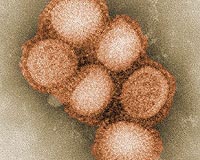| . |  |
. |
Chicago IL (SPX) Mar 08, 2010 Climate change is one reason malaria is on the rise in some parts of the world, new research finds, but other factors such as migration and land-use changes are likely also at play. The research, published in The Quarterly Review of Biology, aims to sort out contradictions that have emerged as scientists try to understand why malaria has been spreading into highland areas of East Africa, Indonesia, Afghanistan and elsewhere. "We assessed ... conclusions from both sides and found that evidence for a role of climate in the dynamics is robust," write study authors Luis Fernando Chaves from Emory University and Constantianus Koenraadt of Wageningen University in the Netherlands. "However, we also argue that over-emphasizing a role for climate is misleading for setting a research agenda, even one which attempts to understand climate change impacts on emerging malaria patterns." Malaria, a parasitic disease spread to humans by mosquitoes, is common in warm climates of Africa, South America and South Asia. The development and survival, both of the mosquito and the malaria parasite are highly sensitive to daily and seasonal temperature patterns and the disease has traditionally been rare in the cooler highland areas. Over the last 40 years, however, the disease has been spreading to the highlands, and many studies link the spread to global warming. But that conclusion is far from unanimous. Other studies have found no evidence of warming in highland regions, thus ruling out climate change as a driver for highland malaria. Chaves and Koenraadt re-examined more than 70 of these studies. They found that the studies ruling out a role for climate change in highland malaria often use inappropriate statistical tools, casting doubt on their conclusions. For example, an oft-cited 2002 study of the Kericho highlands of western Kenya found no warming trend in the area. But when Chaves and Koenraadt ran the same temperature data from that study through three additional statistical tests, each test indicated a significant warming trend. Similar statistical errors plague other comparable studies, the researchers say. In contrast, most studies concluding that climate change is indeed playing a role in highland malaria tend to be statistically strong, Chaves and Koenraadt found. But just because climate is one factor influencing malaria's spread does not mean it is the only one. What is needed, the researchers say, is a research approach that combines climate with other possible factors. "Even if trends in temperature are very small, organisms can amplify such small changes and that could cause an increase parasite transmission," Chaves said. "More biological data will improve our overall understanding of malaria and will allow scientists to propose more general and accurate models on the impacts of climate change on malaria transmission." The authors cite numerous factors that could interact with climate to influence malaria spread. They point to research showing that people migrating from lowlands may be introducing the malaria parasite into highland regions. Changes in farming practices may also play a role. Irrigation associated with more intensive farming may be creating more places for mosquitoes to breed. Another example comes from two studies that linked malaria increases in the Bure highlands of Ethiopia to increased maize farming. There, the immature and aquatic stages of mosquitoes thrive on a diet of maize pollen, and more mosquitoes can mean more malaria. "A major future challenge will be to link up what happens with mosquitoes and parasites at the household level with long-term climate change scenarios at the continental scale," Koenraadt said. The spread of malaria in highlands is of great concern to those who work to contain the disease. But understanding the many factors that influence the spread of highland malaria could help with efforts to control the disease worldwide, Chaves and Koenraadt conclude. "In the light of global efforts towards malaria elimination, highland areas will be interesting starting points from where control efforts could interrupt transmission and aid in shrinking the world's malaria map." Koenraadt said.
Share This Article With Planet Earth
Related Links University of Chicago Press Journals Epidemics on Earth - Bird Flu, HIV/AIDS, Ebola
 Mexico detects first mutation of swine flu
Mexico detects first mutation of swine fluMexico City (AFP) March 3, 2010 Mexican officials said Wednesday they have confirmed the first mutation of the A(H1N1) flu virus in a girl who survived the infection. Health Minister Jose Angel Cordova told Mexican journalists that the case was the first confirmed mutation of the swine flu virus, though there were 423 other suspected cases. He said the girl was treated two months ago at a hospital in Mexico City for a ... read more |
|
| The content herein, unless otherwise known to be public domain, are Copyright 1995-2010 - SpaceDaily. AFP and UPI Wire Stories are copyright Agence France-Presse and United Press International. ESA Portal Reports are copyright European Space Agency. All NASA sourced material is public domain. Additional copyrights may apply in whole or part to other bona fide parties. Advertising does not imply endorsement,agreement or approval of any opinions, statements or information provided by SpaceDaily on any Web page published or hosted by SpaceDaily. Privacy Statement |